





 In 1955 Leo A. Daly designed two buildings for SAC at SAC headquarters, Offutt Air Force Base: the headquarters command post, with above and below ground components, and, the chapel. Both structures were more than functional, and both offered a portrait of the Cold War easily enhanced through imagination. Leo A. Daly designed the SAC command post at Offutt at the outset of February 1955. The post replaced
the simple three-story office building, the A Building, that SAC had adapted from the Martin Bomber
Plant.
The new command post featured a four-story, reinforced concrete and masonry office building
aboveground, more than 16 times larger than the modest administrative A Building. Sometimes called
the Western Pentagon, the aboveground SAC headquarters building was of classic 1950s office design. Although the administrative structure had a basement, it was a segregated, adjacent three-story
structure below ground that served SAC as its command post throughout most of the Cold War
period. Of hardened reinforced concrete, the below ground command post was itself more than five times
the size of the original A Building. The underground command post had 24-inch thick walls and base
floor, with 10-inch thick intermediate floors, and 24-to-42-inch thick roof; blast- and gas-proof doors;
and, ramped tunnels with non-skid surfacing and decontamination areas connecting to an extended tunnel
leading up to the aboveground office building. The final ramped tunnel was eight-foot in diameter,
with two-foot thick reinforced concrete walls.
In 1955 Leo A. Daly designed two buildings for SAC at SAC headquarters, Offutt Air Force Base: the headquarters command post, with above and below ground components, and, the chapel. Both structures were more than functional, and both offered a portrait of the Cold War easily enhanced through imagination. Leo A. Daly designed the SAC command post at Offutt at the outset of February 1955. The post replaced
the simple three-story office building, the A Building, that SAC had adapted from the Martin Bomber
Plant.
The new command post featured a four-story, reinforced concrete and masonry office building
aboveground, more than 16 times larger than the modest administrative A Building. Sometimes called
the Western Pentagon, the aboveground SAC headquarters building was of classic 1950s office design. Although the administrative structure had a basement, it was a segregated, adjacent three-story
structure below ground that served SAC as its command post throughout most of the Cold War
period. Of hardened reinforced concrete, the below ground command post was itself more than five times
the size of the original A Building. The underground command post had 24-inch thick walls and base
floor, with 10-inch thick intermediate floors, and 24-to-42-inch thick roof; blast- and gas-proof doors;
and, ramped tunnels with non-skid surfacing and decontamination areas connecting to an extended tunnel
leading up to the aboveground office building. The final ramped tunnel was eight-foot in diameter,
with two-foot thick reinforced concrete walls.
Historically, and today, the below ground command post is known at Offutt as the �molehole� due to its ramped tunnels and self-contained condition. The SAC headquarters underground command post was in construction during 1955-1957�simultaneous in its later stages with planning for the SAC bomber and tanker alert aprons and semi-subterranean crew quarters, the latter also known as moleholes. The structure also featured lavish and modern connections to the world outside. Its �big board,� a series of maps and postings showing military conditions worldwide, ran along the 264-foot side of the post. In the beginning, SAC updated the board manually, using personnel in cherry-pickers, and making the setting more theatrical through its frontal suspended lighting and drawn curtain. Key military personnel looked down on the big board from glassed-in offices. Communications links were state-of-the-art, with the first SAC command post computer the IBM 704, installed in 1957. The IBM 704, available in 1954-1955, was primarily used in the military and in scientific laboratories, as late as 1959. Six 16-foot data display screens updated SAC personnel in the war room. A �red phone� system, with dedicated connections to 200 operating locations internationally, further supported communications in the SAC underground command post.
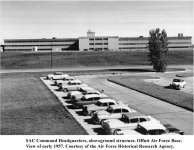
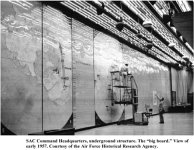
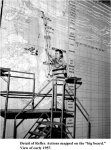
Approximately 1000 people worked underground at the height of the command post�s use, with the capacity to sustain up to 800 people underground for two weeks.
Leo A. Daly handled the new headquarters underground command post assignment, between 1986 and 1989, as it had the first below ground command post in 1955-1957. The SAC command post of the late Cold War was a 16,000 square-foot, two-story reinforced concrete structure, joined to the earlier command center. In addition to reasonable hardening, the new underground command post included protection against electromagnetic pulse. As had been the case in the middle 1950s, the post featured state-of-the-art communications links and information displays. Imagery for SAC was still paramount, with that for this particular subterranean command post even commented upon by the popular author of late Cold War thrillers, Tom Clancy. He wrote in The Sum of All Fears in 1991 that local rumor at Offutt had it that the second generation command post �had been built because Hollywood�s rendition of such rooms was better than the one SAC had originally built for itself, and the Air Force had decided to alter its reality to fit a fictional image.� Fiction or fact, the Clancy observation was not far from true in its understanding of just how much Hollywood film had nurtured the popular understanding of SAC and the Cold War. By 1961, even engineers were using the term �Hollywood hard� in distinguishing between truly hardened infrastructure and visually �hard� infrastructure�the latter always fortress-like for the public, but often vulnerable. As early as 1954, the Air Force Installations Board commented: �Beyond 1960, the increase in weapons yield will be such that�above-ground hardening will not be economically or operationally feasible.�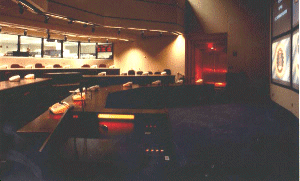
As the nerve center of the United States Strategic Command, the USSTRATCOM Command Center is prepared to transmit National Command Authority directives to strategic aircraft, submarines and missile forces.
The USSTRATCOM Command Center is located in the Underground Command Complex. Also located within this complex are the Intelligence Operations Center, Weather Support Center, Force Status Readiness Center, the Alternate Processing and Correlation Center [APCC]and other support offices.
The Alternate Processing and Correlation Center [APCC] provides an alternate missile warning correlation center to Cheyenne Mountain Air Station (CMAS) for USSPACECOM, and is the prime source of missile warning data for USSTRATCOM for force survival and force management. It is comprised of the integration of the SCIS, CSSR, and CCPDS-R systems as well as numerous non-Cheyenne Mountain upgrade equipment and communications links into a two story, underground, high altitude electromagnetic pulse (HEMP) protected facility at Offutt AFB, NE.
 The USSTRATCOM Command Center is a specially-designed, two-level, 14,000-square-foot reinforced concrete and steel structure containing the critical information management and communication systems to provide the Commander in Chief of USSTRATCOM (CINCSTRAT) an assured capability to manage forces worldwide. In time of war, the underground would be sealed off. An underground emergency power supply, a well supplying an emergency water source, and rations would allow continuous operations without outside support for an extended period of time. Electromagnetic pulse protection is provided for critical command, control and communications equipment as well as supporting utilities. This allows CINCSTRAT to continuously exercise command over USSTRATCOM forces, even in the disturbed electromagnetic environment which would follow a high altitude nuclear burst.
The USSTRATCOM Command Center is a specially-designed, two-level, 14,000-square-foot reinforced concrete and steel structure containing the critical information management and communication systems to provide the Commander in Chief of USSTRATCOM (CINCSTRAT) an assured capability to manage forces worldwide. In time of war, the underground would be sealed off. An underground emergency power supply, a well supplying an emergency water source, and rations would allow continuous operations without outside support for an extended period of time. Electromagnetic pulse protection is provided for critical command, control and communications equipment as well as supporting utilities. This allows CINCSTRAT to continuously exercise command over USSTRATCOM forces, even in the disturbed electromagnetic environment which would follow a high altitude nuclear burst.
When the Command Center is self-contained, CINCSTRAT and members of the senior staff would work in the lower level senior battle staff area, while support staff members would take designated positions in the support battle staff area on the second floor.
Workstation consoles provide CINCSTRAT and senior and support battle staff members state-of-the-art integrated secure/nonsecure voice communications and data management systems. Individual video monitors at each console position provide an advanced capability to display information essential to decision making and to manage the command's aircraft and missile forces. Support battle staff members have individual computer terminals which access an advanced automatic data processing system that provides word processing, spreadsheets, computational aids, graphic/tabular decision making information and automated briefing preparation and presentation.
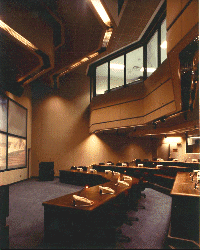
The Command Center's group display and briefing support system provides the capability to display full motion video and still frame imagery on eight large wall screens and individual video monitors. It also allows video communications between the Command Center and weather and force status readiness centers; the capability to convert hard copy, 35 mm slides, or overhead transparencies into video; and rapid access to worldwide maps. Within seconds, vital operational data can be displayed on the large wall display screens or individual computer monitors. The primary system for storing and supplying this data is the USSTRATCOM Automated Command Control System. Information about weather, force movements, aircraft and missiles is stored in computers, ready for immediate access. Field units continually update the data.
In time of war, the computers would record strike force progress, serving as an invaluable aid to CINCSTRAT in making command and operations decisions. Because the information would be processed automatically, the battle staff would have immediate and continuous updates on its strike force.
The Primary Alerting System, using dedicated telephone circuits, enables USSTRATCOM controllers to speak directly to approximately 200 operating locations throughout the world, including missile launch control centers. Through this "Red Phone" system, each unit receives coded messages giving notice of an actual or practice alert. The Senior Controller also has a direct line to the National Military Command Center in Washington, DC, and to the other major command headquarters. This system, called the Joint Chiefs of Staff Alerting Network, allows CINCSTRAT prompt contact with the President, the Secretary of Defense, the Chairman of the Joint Chiefs of Staff, and other unified commanders.
Through satellites and radio networks (VLF, LF, UHF and HF), the Command Center can communicate with aircraft in flight over any part of the world. A principal purpose of these networks is to pass National Command Authority orders to the alert forces. Several detection systems provide the USSTRATCOM Command Center with Intercontinental Ballistic Missile (ICBM) and Sea-Launched Ballistic Missile (SLBM) attack warnings. This information is processed through high-speed computers for display on the Command Center's large screens, the CINCSTRAT's video monitors, and the Warning System Controller's video monitors.
Information shown on these screens would instantly alert the Senior Controller of an ICBM or SLBM attack against the North American continent or our allies. These systems, along with summary information and attack assessment from other military commands, permit CINCSTRAT to protect his force pending the presidential decision. Although CINCSTRAT can launch aircraft for survival, only the President can order nuclear strikes. In the event the USSTRATCOM Command Center becomes inoperable, control of strategic forces would be passed to the USSTRATCOM Airborne Command Post, which is ready to become airborne 24 hours a day.
